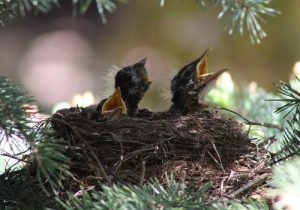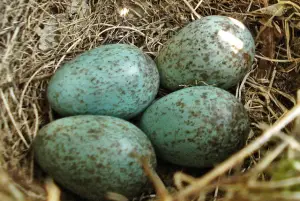Crows of the Corvidae family's Corvus genus, are extremely clever birds. Crows are capable of abstract reasoning and may even think like us.
So…
What about baby crows? Baby crows are a pretty uncommon sight, and there are several reasons why many people never see one.
This article will cover all you need to know about newborn crows, with lots of photographs of the secretive bird along the way!
Specifications Of A Baby Crow

What Does A Baby Crow Looks Like?
Most crow chicks have a light coating of scruffy and fluffy feathers when they hatch. Some crow chicks are nearly naked, with huge pinkish bills. Another distinguishing feature of infant crows is their bright blue eyes, which make real baby crows and juveniles very easy to distinguish from adults.
What Is The Size Of A Baby Crow?
Length
When crows hatch, they are just a few millimeters long, but they develop quickly, gaining nearly their adult size before fleeing the nest after about a month.
The species in the crow family that have 'crow' in their common name are all about the same size.
For example, the smallest, the little crow, is 42 to 48cm long, while the biggest crows are only about 55cm long.
While ravens are of the same genus as crows, they do not have the word "crow" in their common name - but they're still considered crows in certain ways.
Weight
Baby crows are around 30 grams in weight (1 oz). Many hatch naked and mostly unfeathered, but after a day or two, feathers begin to sprout.
After 30 days, most American crow babies weighed roughly 300g to 350g, according to research, at which time they began to leave the nest.
What Are The Appearances Of Juvenile Crows?
These crows have slicker feathers than juvenile crows, which are sometimes scruffy or puffy. This is frequently the easiest method to tell the difference between juvenile and adult crows.
Young crow beaks are typically shorter and lighter in color in juveniles than in adults.
Blue eyes are a distinguishing feature of this certain baby birds, although this isn't a reliable way to distinguish a fledgling crow from an adult because it only pertains to a few species, such as the American crows and Torresian crows.
Young birds of this species are frequently seen being mischievous, interacting with one another, cawing loudly, and jumping around frantically.
What Do Fledgling Crows Eat?

The father and helpers usually feed the young bird, while the mother stays with them.
Yes, some crow families do have helpers, and we'll go into this in more depth later!
In a nutshell, young crows are given soft meals that are regurgitated by their parents - or helpers - for around two weeks before being fed more solid items.
During the brooding period, crow parents are extremely cooperative. The female normally does the brooding, especially in the first week, and stays in the nest for most of the day to keep the chicks warm until they are around two weeks old.
While some crow species form long-term pair connections that are solitary, most birds participate in cooperative breeding. Even more solitary crow species, such as the Hooded crow, have been documented cooperating in breeding.
Crow Eggs

Crow eggs are easily identified by their olive or blue-green coloration and dark brown spots that are concentrated at the big end.
How Long Do Crow Eggs Hatch?
Most crow species have a relatively short incubation period of 18 to 21 days. For the most part, the female will remain on top of the eggs, and either the father or assistants will bring her food.
How Many Eggs Do Crows Lay?
The clutch sizes of various crows vary somewhat. Carrion crows lay between 4 and 6 eggs, whereas American and Hooded crows lay 3 to 5. On average, the New Caledonian crow lays 2 to 3 eggs.
Most species of crows can lay another clutch if their previous clutch is lost early in the mating season.
Cooperative Breeding In Crows

Crows sharing nests and defending territory as a single unit, as well as collectively helping nurture chicks, are examples of cooperative breeding.
Some crow species have 'assistants,' which are only seen in a few other birds such as nuthatches and kingfishers.
Cooperative breeding is extremely rare; according to one research, cooperative breeding is seen in only 3.2 percent of bird species.
The American crow is one of the most well-known cooperative breeders, with enormous family units that include several helpers.
Helpers are frequently the parents' children from the previous season or are linked to the parents in some manner, however, there is evidence that helpers come from beyond the family unit.
These helpers aid with everything from constructing the nest to feeding the chicks, and they may even help the female with brooding.
Several helpers presented the female with more twigs than she could utilize to build a nest, resulting in a chaotic mess, according to one story of cooperative breeding recorded in the American crow.
Some argue that corvid intelligence permits crows and other corvids to form intimate and long-lasting friendships in the same way that primates, humans, and other highly intelligent animals like dolphins do.
These relationships aid in growth and survival while also providing opportunities for social interaction.
Do Crows Reuse Nests?
Crow nests seldom last the entire year, especially considering that crows only occupy the nest for around 20 days.
The nest's function is completed after the chicks leave the nest and fledge.
Crows frequently return to the same breeding grounds year after year, and they may even return to a nesting spot near their previous one.
How Long Do Baby Crows Stay In Their Nests?
Before they fledge in earnest, baby crows leave the nest for a short time, usually only staying for 20 to 30 days.
Before they can fly competently, chicks will go to a neighboring perch or the ground.
Once fledged, crow juveniles are not self-sufficient and will remain with their parents for several weeks, if not months or years.
After fledging, parental care normally lasts another 2 to 3 months, although, unlike many other birds, crow families often stay together for a long time.
How Long Do Baby Birds Stay On The Ground?
If you observe a baby crow (or any other corvid babies), they're likely sitting on the ground rather than perched on a limb.
This does not imply that the baby bird has been abandoned by its parents; the parents are most likely nearby.
A baby bird of crows frequently spends a day or two on the ground after fledging before learning to fly to and from their treetop perches.
Birdhub Talk: Our next article is somewhat gruesome! Flutter along to this page and know why -- What Is A Group Of Crows Called?
Watch This!
Frequently Asked Questions
What is called the baby of crows?
This species' newborns are given a chick name. They become hatchlings and nestlings when inside a nest and fledglings when they leave the nest after hatching. Yearlings are baby crows that range in age from two weeks to three years.
Why do you not see baby crows?
Many babies were undoubtedly seen in the sky crow in the past, but people confuse babyness with smallness. Some bird species will jump from nests before they reach adulthood, but they will not be able to fly.
What do you do when you find a baby crow?
To make the birds flap, raise your palm to your hand. The infant frequently vocalizes to catch the attention of the bird.
Can you keep a crow as a pet?
Crows are not allowed to be kept as pets in the United States. The Migratory Birds Act of 1916 made it illegal to own any birds that migrate to America. A registered wildlife rehabilitation organization is required, save in exceptional circumstances. Both crows and ravens are protected under the statute.
Conclusion
We've now witnessed one of the most striking spectacles. We hope this information has answered your queries and aroused your curiosity about these clever birds.
We wish you happiness as you make friends with these incredible birds. While viewing native birds in their natural habitat, remember to preserve their peace and solitude.
